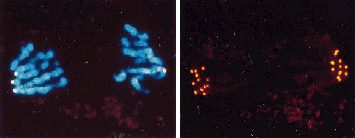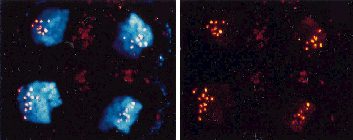|
|
The process, during which the germ cells are generated is called meiosis. It represents nature's solution of the problem of chromosome doubling that would occur, if two diploid cells, i.e. two cells with a double set of chromosomes would fuse. Accordingly meiosis produces haploid germ cells, with maternal and paternal germ cell fusing at fertilization and thus generating a diploid fusion product, the zygote. Meiosis is made up by two subsequent processes, both of which resemble mitosis. In the first process the homologous chromosomes are separated. It has an unusually long prophase that is subdivided into different stages: leptotene, zygotene, pachytene, diplotene and diakinesis. They are followed by metaphase, anaphase and telophase.
|
Upon fertilization two nuclei fuse, so that the
number of chromosomes does necessarily double. If this thought is
spun further, an exponential growth of the number of chromosomes from
generation to generation would have to be expected. This is not the
case, because the chromosomes are reduced to half their normal number
in germ cell production. This process is called meiosis.
It consists of two successive mitosis-like divisions: in the first
division is the number of chromosomes reduced to their half, the
second is a normal mitosis.
Each germ cell contains a complete set of chromosomes, a haploid set. Accordingly the cells are haploid and zygotes and the body cells that stem from them are diploid, because they contain two equal sets of chromosomes, one from the mother and one from the father. There exist, especially in plants, also triploid, tetraploid...polyploid cells. We will later on also have a closer look at their production.
At the end of the last century (1883, 1887, 1888) the Belgian zoologist E. van BENEDEN and the German zoologist T. BOVERI studied meiosis.Both understood its eminent importance. At nearly the same time E. STRASBURGER found that two successive mitoses occur in the pollen tube of many lily species. In 1884 he began to reproduce these experiments in his courses. Still, it does not become clear, neither in the text nor in the drawings that the number of chromosomes is reduced to half the original amount during the first division. It was not before 1889 that he could prove this using Allium as his specimen. In the same year J. L. L. GUIGNARD described the reduction of the number of chromosomes in Lilium martagon. Contrary to mitosis the prophase of the first meiotic division takes unusually long and can be subdivided into several phases. During this time the homologous chromosomes pair.
The single phases as we know them today are shown in the following pictures.


At the beginning of meiosis, in prophase 1 the nuclear envelope disintegrates and chromosomes become visible as in mitosis (1). The chromosomes have replicated but individual chromatids are not visible. Instead of lining up on a metaphase plate, as in mitosis, chromosomes come together in pairs (2). Each chromosome in a pair is similar in structure (homologous), but would have come originally from different parents. Later in prophase the homologous pairs twist round each other and chromatids may cross over (3). Breaks occur at these cross-overs (or chiasmata, singular chiasma) and pieces of chromatid are exchanged (4). Chromosome pairs line up across the equator of the spindle at metaphase I (5). In anaphase I the chromosomes separate and travel to opposite ends of the spindle. The chromosomes migrate to the equators of two new spindles for metaphase 2 (7). Next the chromatids are pulled apart in anaphase 2 to form four clusters of chromosomes in telophase 2. The nuclear envelopes reform around four haploid nuclei that will give rise to the micro- or megagametophyte. - © M. Knee
The leptotene. This phase differs only slightly from the early stages of mitosis. The cells and nuclei of meiotic tissues are usually bigger than that of their neighbouring tissues and they do often seem to be longer and are longitudinally structured. At regular intervals thickenings can be found, like beads on a string: the chromomeres. Their number, size and positioning is constant in each species. A trained cytologist can infer from their structure to their identity. In 1931 J. BELLING (University of California, Berkeley) did count 1500 - 2000 chromomeres in the haploid chromosomal set of a lily species.

Distribution of the centromeres during Prophase 1
pollen formation in Lilium longiflorum
The zygotene. During this
phase the pairing of homologous chromosomes begins. It is also called
synapsis and the resulting
structure synaptic complex.
Directly after initiation of the process the pairing spreads like a
zipper across the whole length of the chromosome.
The pachytene. During the
pachytene the pairing stabilizes. The number of synaptic complexes
corresponds to the number of chromosomes in a haploid set of the
respective species. The pairs are also called bivalents.
The diplotene. The bivalents
separate again. During this process it emerges that each chromosome
is built of two chromatids, so that the whole complex harbours four
strands during the separation. Normally the separation is not
accomplished, but the homologous chromosomes stick together at
certain points, the chiasmata (sing. chiasma).
This state is marked by the formation of cross-like structures,
single or multiple loops.
The diakinesis is the
continuation of the diplotene. It is usually difficult demarcate both
states. The chromosomes condense and become more compact.
The metaphase. From now on the
processes resemble that of mitosis again. The nuclear membrane is
completely dissolved, the mitotic spindle fully developed. The
homologous chromosomes do still stay together.
The anaphase. During anaphase the homologous chromosomes are separated from each other. It is followed by the telophase, then by interkinesis (this state corresponds to the so-called quiescence or interphase state). Shortly afterwards the second mitotic division with the usual states of prophase, metaphase, anaphase and telophase occurs. Here the chromatids are separated from each other.

Distribution of the centromeres during the meiosis.
Pollen formation in Lilium longiflorum
As a result of the meiosis of a diploid cell, four haploid cells (gones) form, of which one (at egg cell formation) or all (at pollen formation) can develop into gametes.

|
|